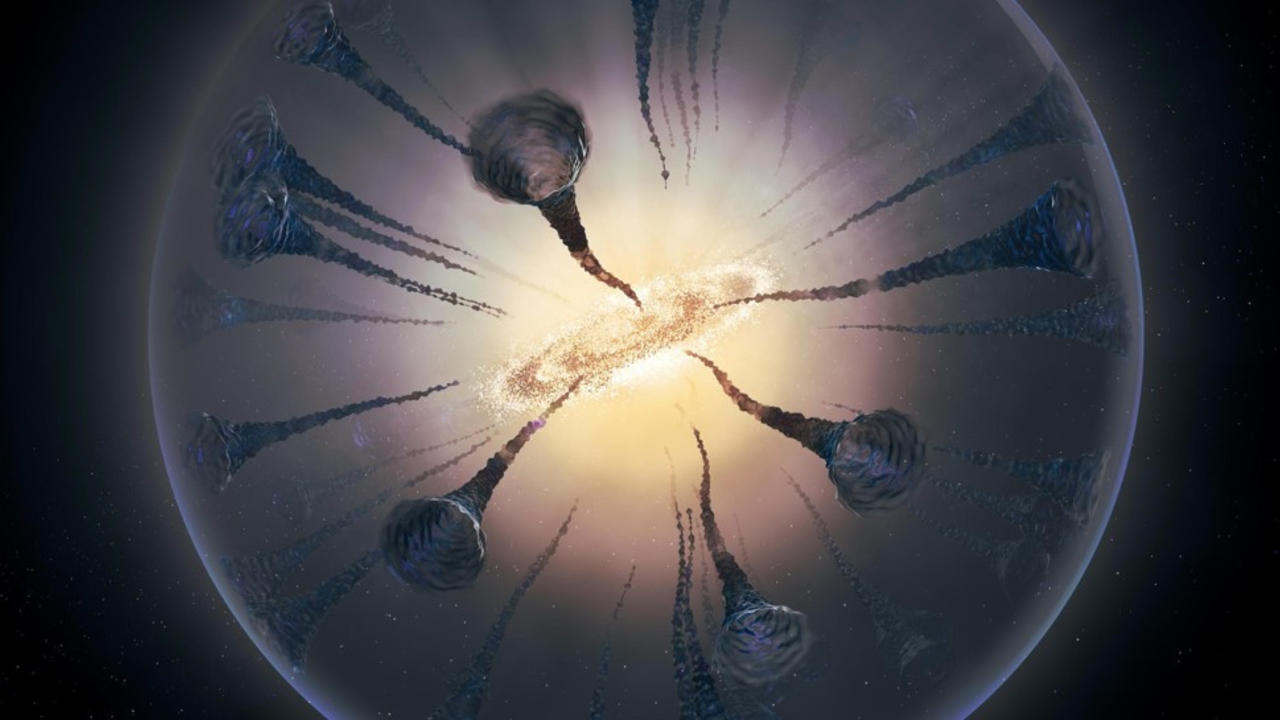🔬 Research Knowledge from the Field of Master Mind Physics (MMPHY) 💥
Shared from the research of: Joseph Mercado 🙇
Article Author: Dr. Amira Val Baker 👩
Content Contributor: Resonance Science 🌏
Blog Post #1161 📌
Re: What Is An Electron❓
Date and Time: Tuesday, 30, 2021 at 12:27 p.m. ⏳
Dear Physics Lover,
Everyone knows what an electron is – right? Surprisingly the answer to that is no – no one really knows what it is.
If you ask any high school student what an electron is, they will most probably tell you that it is a subatomic particle with negative charge and acts as the primary carrier of electricity.
This answer is indeed correct – however it does not reveal the true nature of its reality.
This fundamental question has been the driving force for much of modern physics – and eventually led to the development of quantum field theory – yet we are not any closer to finding an answer.
To answer this question, you would think the first step would be to observe it.
However, that is easier said than done. Electrons are simply too small for us to observe – the smallest thing we can observe is an atom and even that is not with a traditional microscope.
In fact, we use electrons to observe atoms.
This method of observation works by using a beam of accelerated electrons as a source of illumination – allowing us to observe objects a million times smaller than a human hair (~ 0.1 nm) which is just enough to “view” individual atoms.
So, we can’t observe an electron, however we can observe its behavior, more specifically its energy.
Currently this is done with Penning traps – a special device developed in the 1970’s with the purpose of trapping particles for extensive periods of time so that accurate measurement could be made.
The Penning trap works by applying a superposition of a strong homogeneous magnetic field, providing radial confinement, and a weak electrostatic quadrupole field, providing axial confinement.
The cyclotron frequency – that is the frequency of the charged particle’s circular motion perpendicular to the magnetic field – is proportional to the charge-to-mass ratio.
Ions of the same charge-to-mass ratio will undergo the same amount of deflection.
If we measure the amount of deflection experienced in the Penning trap and compare it with the amount of deflection experience by an ion of well-defined mass e.g. carbon-12 then the mass of the unknown particle can be determined.
What is important to note is that when we make such a measurement of the energy, we are in fact making a measurement of a single ion (i.e. an electron surrounding a central nucleus) – not a single electron.
So, if we can’t see the electron how did we discover it?
The electron was discovered in 1879 by J. J. Thompson when he was investigating the bright glow observed on a phosphorescent screen when a high voltage is applied across two electrodes in a partially evacuated tube – a cathode ray tube.
These ‘rays’ or ‘particle beams’ are known as cathode rays as they originate from the cathode.
To investigate their properties, transverse magnetic and electric fields were applied, and in each case resulted in the deflection of the cathode ray towards the positive and away from the negative indicating that they are of negative charge.
Further experimentation allowed Thompson to determine the mass-to-charge ratio of the cathode ray particles, which were found to be much smaller than that of any known atom.
Thompson was also intrigued as to whether the cathode was the source of the particles and he thus changed the material and found that the properties of the cathode ray remained constant no matter what cathode material they originated from.
From all these experiments Thomson concluded that the electron was a particle that made up all matter and ended the idea that the atom was the smallest particle. Instead the atom was made up of these subatomic particles which he called corpuscles and are now referred to as the electron.
Several models were put forward that explained this new understanding of the atom.
The first was proposed by Thompson himself, which he derived from the observation that the electrons are negatively charged and therefore to make a neutral atom there must a source of positive charge to balance out the electrons.
He thus suggested that an atom is composed of electrons surrounded by a soup of positive charge.
This became known as the plum pudding model with the negatively charged plums surrounded by positively charged pudding.
However, the plum pudding model was later found to be incorrect when Ernest Rutherford carried out his famous gold leaf experiments along with Geiger and Marsden, in which he bombarded a thin sheet of gold with alpha particles (+ve charged) and found that most of the particles passed through the sheet and only a small percentage of the particles were deflected.
Rutherford thus concluded that the mass of an atom was concentrated at its center and thus proposed a model with a positive central nucleus surrounded by negatively charged electrons.
This model was further developed with the help of Niels Bohr, but instead of the electrons being randomly distributed he proposed that they existed in orbitals – orbiting the central positive nucleus analogous to planets orbiting a central nucleus/star.
Now with any model we should be able to explain what we are observing. So, when a spectral analysis of hydrogen was made – that is when the light emitted from a hydrogen gas passes through and is refracted by a prism – discrete emission lines are observed.
In the Bohr model, the emission lines are explained by the transition of electrons between orbitals – so when light energy is absorbed by the electron it transitions to a higher energy level – this higher energy level is excited and is therefore not as stable so when it relaxes back to a stable state it emits a photon as it drops down to a lower energy level – and it is this emitted photon that is observed.
However, the Bohr model was only able to explain the emission spectra for hydrogen or other single electron atoms like ionized helium.
For multi-electron atoms, the spectral analysis showed many more discrete emission lines that could not be explained by the Bohr model.
That is where the quantum model took over which instead of explaining the electron as extended sources in discrete orbits, it treats the electron and positron as point particles with no internal structure.
Unlike the Bohr model the electrons don’t exist in precisely-defined orbits and instead all that is known about these point particles is their probable distribution around the atom – generally referred to as an electron cloud.
The electron cloud model was developed in 1926 by Erwin Schrödinger and Werner Heisenberg and can be explained in terms of a probability wave – specifically the Schrodinger wave equation – where the states or ‘orbitals’ that an electron can occupy in an atom is analogous to that of a standing wave.
In the quantum model these states, or orbitals depend on a set of quantum numbers for example the principle quantum number n, the angular momentum number l, the magnetic number m, and the spin numbers.
The different shapes and sizes of these probability distributions/orbitals can be further explored here.
It is these different quantum numbers that define the position and momentum in terms of a probability cloud and describe the emission lines that were unaccounted for in the Bohr model.
As well the quantum model was extended to explain emission lines that occur due to an external magnetic field and/or due to interactions with the quantum vacuum.
However, although this model is very successful and can explain what the Bohr model can’t – it still does not explain the electron and where its mass comes form.
In fact, in both these models the mass is not derived from first principles and instead is only known empirically.
The standard definition for the mass of the electron is therefore generally given in terms of the Rydberg constant (a constant relating the emission lines to the energy)
So how do we reveal the nature or structure of an electron?
For a clearer picture of the electron to emerge maybe its time to look at a quantized view of the universe from the very small to the very big.
The generalized holographic model introduced by Nassim Haramein offers such a view – and it’s all about those Planck units – defining the fundamental quantized information bit, or voxel, of the universe.
In this model, which expands on the work of physicists David Bohm, Jacob Bekenstein, Stephen Hawking and Gerard ’t Hooft, the energy – or information – of any spherical system is proportional to the number of Planck Spherical Units (PSUs) or voxels within the spherical volume (volume entropy) and the number of voxels available on the spherical surface horizon (surface entropy).
This holographic relationship between the interior and the exterior defines the mass-energy density of the system while the inverse defines the mass expressed by the system at any given moment – or as described by David Bohm, the unfolded and the enfolded, respectively.
The question is – can this approach be extended to the electron? The first step in answering this question is to consider the spatial extent of the electron and the volume of information that it encloses.
However, the spatial extent of the electron hasn’t been conclusively defined – so what radius do we use?
The generalized holographic approach sees mass as emerging from the granular Planck scale structure of spacetime in terms of a surface-to-volume information transfer potential, which decreases with increasing radius.
So if we start with the premise that an electron cloud can be considered as an ‘electron’ coherent field of information then instead of thinking about the electron as a separate system, the electron could be thought of as a cloud of potential energy spatially extending from the proton out to the radius where the volume encloses the electron cloud of a hydrogen Bohr atom.
When we utilize this approach, we find an electron mass solution in terms of the holographic surface-to-volume ratio – the transfer potential – and a mass equivalent to the experimentally measured mass of the electron,
A picture develops in which the structure of the Bohr atom and the charge and mass of both the proton and the electron are consequences of spin dynamics in the co-moving behaviour of the Planck scale granular structure of spacetime.
So, we now have a physical model that gives us a deeper understanding of the nature of the electron and it gives the correct mass!
As well, when we extend this model for successively smaller radii – atomic radii – we find the mass for the total number of electrons in each element.
The solution gives a clear insight into the structure of all the atoms of the table of elements, in terms of the electron cloud being composed of quantum vacuum fluctuations at the Planck scale.
As a result, an elucidation of the source of the fine structure constant, the Rydberg constant and the proton-to-electron mass ratio is determined in terms of vacuum energy.
So, from the granular Planck scale structure of spacetime the generalized holographic approach gives us the mass of a black hole, the mass of the proton and now the mass of the electron.
Details of this work: The Electron and the Holographic Mass Solution. Val Baker, A. K. F., Haramein, N. and Alirol, O. (2019). The Electron and the Holographic Mass Solution, Physics Essays, Vol. 32, Pages 255-262
Content Source: Resonance Science

 Email Us a Message
Email Us a Message 

Please send us a personal message below and we will serve you momentarily.
We appreciate you visiting the MMU Global Research Directory
For more blog posts, videos, articles, and to generate more knowledge, please feel free and…






 Fly Over to the MMU Facebook Page with Hoot
Fly Over to the MMU Facebook Page with Hoot
 Visit the MMU Facebook Group Today
Visit the MMU Facebook Group Today 